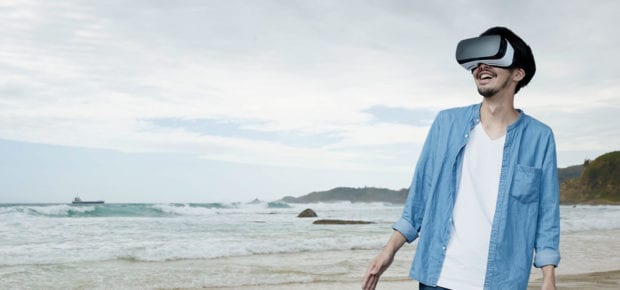December 23, 2019
With the start of winter, those in the Northern Hemisphere may be shopping for a beach vacation before the cold weather blues settle in. Today it’s possible to sample some of the sights and sounds of different beach destinations before choosing, thanks to the help of VR (virtual reality).
Can VR appeal to our sense of touch and smell? Can it help us see sights that we missed while traveling? Can it replace travel altogether? We asked IEEE member Todd Richmond about the potential of VR to transform the travel industry.
IEEE: How is VR being used today in the travel industry?
Todd Richmond: To date, VR has been used essentially as a high-tech brochure before a trip. Some travel companies are using 360-degree videos, a form of “casual VR,” to allow consumers to “look around” a vacation spot by simply using Samsung Gear (wearable computing devices), Google Cardboard (a low-cost VR platform), or the equivalent even before they’ve packed a bag. More immersive experiences require much more development effort and costs on the part of travel vendors, and on the part of the consumer, a computer and VR headset, which most people don’t have.
IEEE: What capabilities does VR provide to travelers that they didn’t have before?
TR: A traveler can “look around” an environment – be it a hotel room, club, street scene or wilderness area. The ability to interactively view (by turning your head and body) is a bit more immersive than a traditional video, and gives the user some degree of agency to look where they want. Audio can be part of the experience, as spatial audio is becoming more common. But touch and smell remain experimental and can be expensive to deploy.
IEEE: What other travel applications can we expect VR to tap into in the future?
TR: Two other possibilities could be intriguing. The first is the ability to relive the trip, by watching 360-degree video that was captured during the trip. Just like travel photos, travel 360s could provide a more immersive memory experience, and also provide the possibility of seeing things that were missed during the actual trip (“I didn’t look over there”).
The second possibility is for VR to replace travel. This has been the stuff of science fiction for decades, but as we get better at deep immersion and telepresence, it could be that much of our travel experience will happen from the privacy and security of our homes. The next step for this is to enable social interactions on the VR-enabled “trip”. These capabilities will see double-duty in the workplace for telecommuting.
See also Experience History and Art In a Whole New Way with AR and VR in Museums
IEEE: In your view, will VR create more armchair travelers, or will it inspire people to go out and experience the real thing?
TR: I think you’ll see both. Like with any technology, people use it in a variety of ways – some for positive outcomes, some with unintended consequences. Since VR breaks time and space, it can enable people to virtually travel to places that they can’t actually get to (e.g., Mount Everest) or places that are no longer like they used to be, like any rapidly growing area.
With a growing older population virtual travel may end up helping with feelings of isolation and allow “travel” even when someone has debilitating physical limitations. This type of stimulation could help keep mental acuity as people age. Of course, more studies need to be done to determine the benefits of these types of experiences but the possibilities are there.






 Meaningful Momentum or Running in Place?
Meaningful Momentum or Running in Place? AI Through Our Ages
AI Through Our Ages Liquid Infrastructure: Our Planet's Most Precious Resource
Liquid Infrastructure: Our Planet's Most Precious Resource The Impact of Technology in 2025
The Impact of Technology in 2025 Quantum and AI: Safeguards or Threats to Cybersecurity?
Quantum and AI: Safeguards or Threats to Cybersecurity? Why AI Can't Live Without Us
Why AI Can't Live Without Us Bits, Bytes, Buildings and Bridges: Digital-Driven Infrastructure
Bits, Bytes, Buildings and Bridges: Digital-Driven Infrastructure Impact of Technology in 2024
Impact of Technology in 2024 Emerging AI Cybersecurity Challenges and Solutions
Emerging AI Cybersecurity Challenges and Solutions The Skies are Unlimited
The Skies are Unlimited Smart Cities 2030: How Tech is Reshaping Urbanscapes
Smart Cities 2030: How Tech is Reshaping Urbanscapes Impact of Technology 2023
Impact of Technology 2023 Cybersecurity for Life-Changing Innovations
Cybersecurity for Life-Changing Innovations Smarter Wearables Healthier Life
Smarter Wearables Healthier Life Infrastructure In Motion
Infrastructure In Motion The Impact of Tech in 2022 and Beyond
The Impact of Tech in 2022 and Beyond Cybersecurity, Technology and Protecting Our World
Cybersecurity, Technology and Protecting Our World How Technology Helps us Understand Our Health and Wellness
How Technology Helps us Understand Our Health and Wellness The Resilience of Humanity
The Resilience of Humanity Harnessing and Sustaining our Natural Resources
Harnessing and Sustaining our Natural Resources Creating Healthy Spaces Through Technology
Creating Healthy Spaces Through Technology Exceptional Infrastructure Challenges, Technology and Humanity
Exceptional Infrastructure Challenges, Technology and Humanity The Global Impact of IEEE's 802 Standards
The Global Impact of IEEE's 802 Standards Scenes of our Cyber Lives: The Security Threats and Technology Solutions Protecting Us
Scenes of our Cyber Lives: The Security Threats and Technology Solutions Protecting Us How Millennial Parents are Embracing Health and Wellness Technologies for Their Generation Alpha Kids
How Millennial Parents are Embracing Health and Wellness Technologies for Their Generation Alpha Kids Space Exploration, Technology and Our Lives
Space Exploration, Technology and Our Lives Global Innovation and the Environment
Global Innovation and the Environment How Technology, Privacy and Security are Changing Each Other (And Us)
How Technology, Privacy and Security are Changing Each Other (And Us) Find us in booth 31506, LVCC South Hall 3 and experience the Technology Moon Walk
Find us in booth 31506, LVCC South Hall 3 and experience the Technology Moon Walk Virtual and Mixed Reality
Virtual and Mixed Reality How Robots are Improving our Health
How Robots are Improving our Health IEEE Experts and the Robots They are Teaching
IEEE Experts and the Robots They are Teaching See how millennial parents around the world see AI impacting the lives of their tech-infused offspring
See how millennial parents around the world see AI impacting the lives of their tech-infused offspring Take the journey from farm to table and learn how IoT will help us reach the rising demand for food production
Take the journey from farm to table and learn how IoT will help us reach the rising demand for food production Watch technical experts discuss the latest cyber threats
Watch technical experts discuss the latest cyber threats Explore how researchers, teachers, explorers, healthcare and medical professionals use immersive technologies
Explore how researchers, teachers, explorers, healthcare and medical professionals use immersive technologies Follow the timeline to see how Generation AI will be impacted by technology
Follow the timeline to see how Generation AI will be impacted by technology Learn how your IoT data can be used by experiencing a day in a connected life
Learn how your IoT data can be used by experiencing a day in a connected life Listen to technical experts discuss the biggest security threats today
Listen to technical experts discuss the biggest security threats today See how tech has influenced and evolved with the Games
See how tech has influenced and evolved with the Games Enter our virtual home to explore the IoT (Internet of Things) technologies
Enter our virtual home to explore the IoT (Internet of Things) technologies Explore an interactive map showcasing exciting innovations in robotics
Explore an interactive map showcasing exciting innovations in robotics Interactively explore A.I. in recent Hollywood movies
Interactively explore A.I. in recent Hollywood movies Get immersed in technologies that will improve patients' lives
Get immersed in technologies that will improve patients' lives